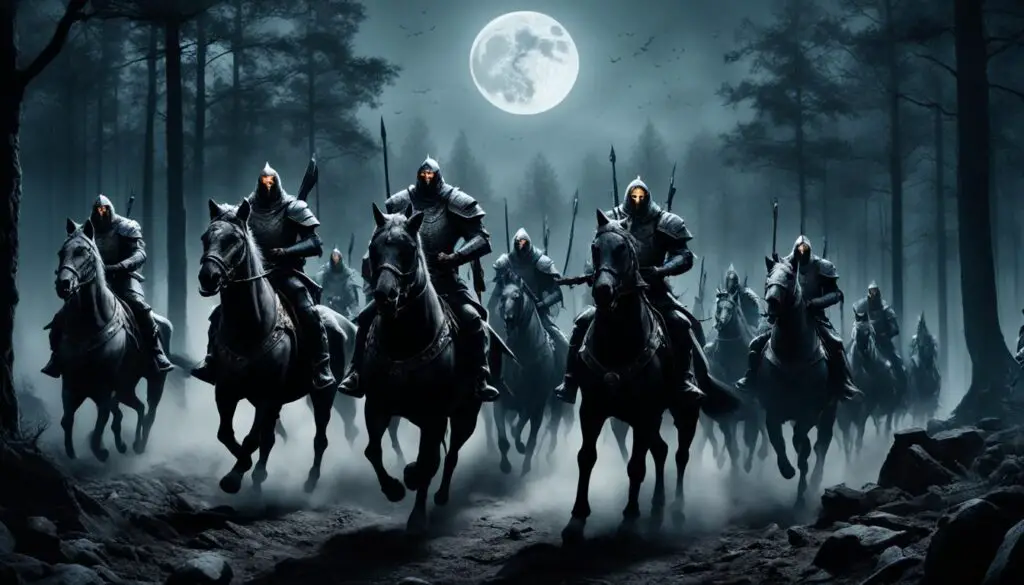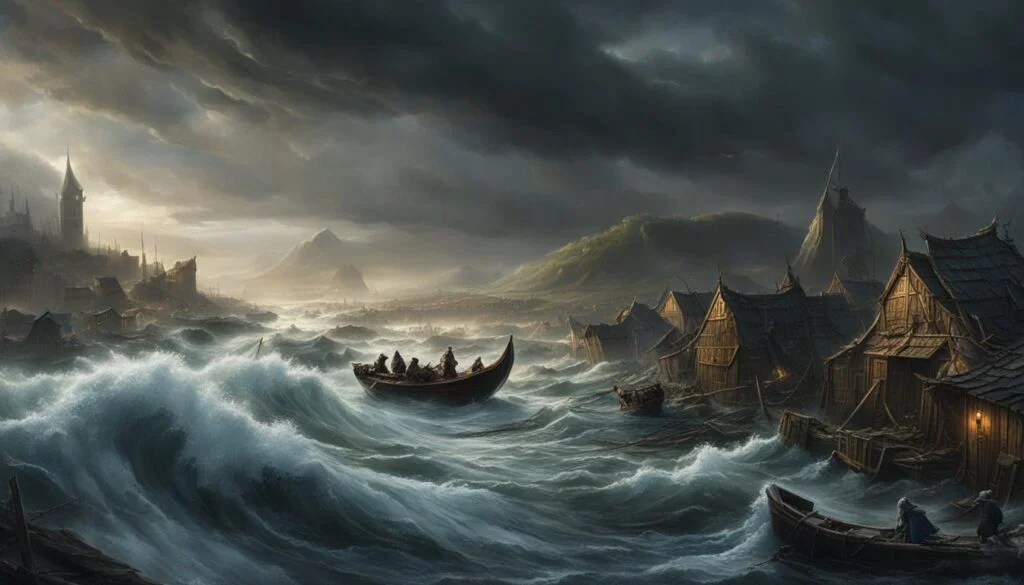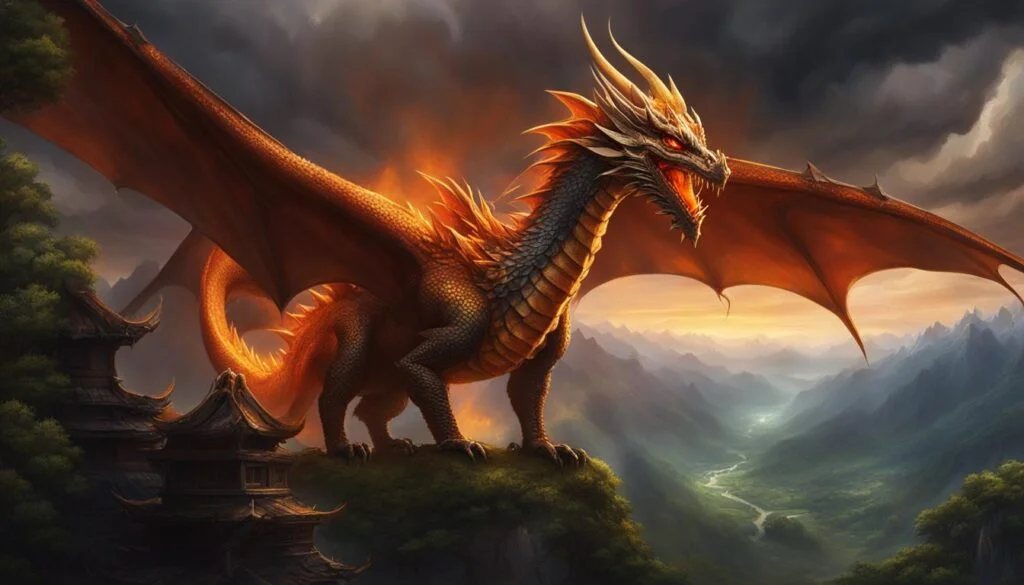Have you ever wondered when the Wild Hunt takes place in Norse mythology? This mythical event, often associated with the god Odin, is a great hunting party led by Odin and his horse Sleipnir, believed to occur across the sky. While the exact timing of the Wild Hunt in Norse mythology is not clearly defined, it is linked to various natural phenomena and is often seen as a symbol of impending doom. Let’s delve into the legends and folklore surrounding the Wild Hunt to understand more about its timeline and significance.
Key Takeaways:
- The Wild Hunt in Norse mythology is a great hunting party led by Odin and his horse Sleipnir.
- The exact timing of the Wild Hunt is not clearly defined, but it is linked to various natural phenomena.
- The Wild Hunt is often seen as a symbol of impending doom.
- Legends and folklore contribute to the rich history of the Wild Hunt in Norse mythology.
- The Wild Hunt holds cultural, mythological, and astronomical significance.
The Origins of the Wild Hunt
The concept of the Wild Hunt can be traced back to Germanic mythology, with Jacob Grimm documenting it as a mythological trend in his collection of German fairytales. In Norse mythology, the Wild Hunt is often associated with Odin, the powerful god of war and the sky.
Similar to the awe-inspiring descent of Odin’s Valkyries from Valhalla, the Wild Hunt is said to involve ghostly hunters traversing the heavens. This mythical event captivates the imagination, depicting a grand hunting party led by Odin and his majestic horse, Sleipnir.
The legends and myths surrounding the Wild Hunt extend beyond Norse mythology, with variations of this tale found in cultures such as Wales and England. In these variations, different figures take on the role of the hunt’s leader, adding depth and diversity to the folklore.
The rich tapestry of tales and legends associated with the Wild Hunt in Norse mythology contributes to its enduring legacy, firmly establishing it as a captivating aspect of Norse folklore.
Image: Wild Hunt – Norse god Odin leading the ghostly hunt across the sky.
Explaining the Wild Hunt
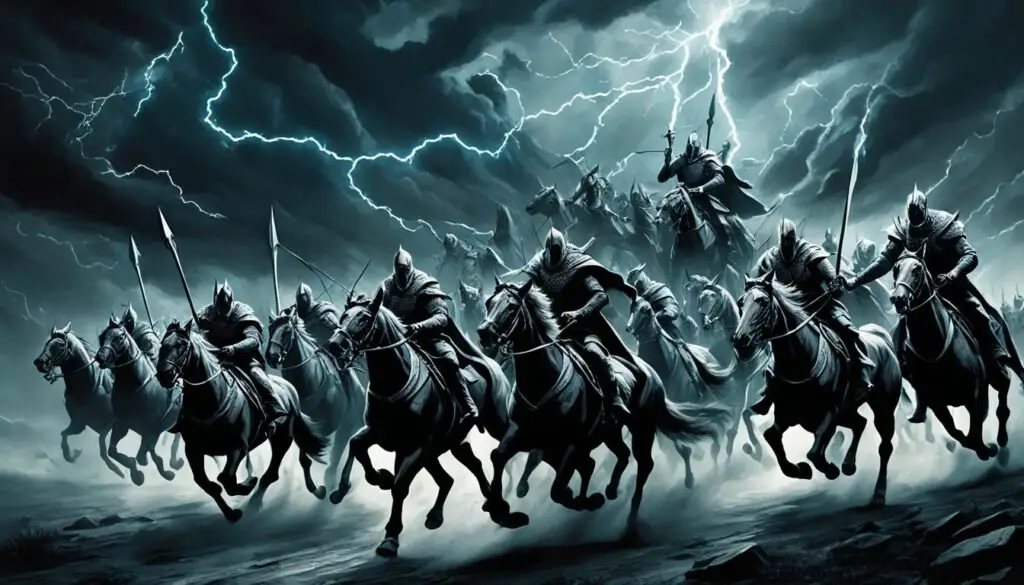
The Wild Hunt in Norse mythology has long fascinated scholars and enthusiasts. It is often seen as an allegory to explain drastic weather shifts, especially thunderstorms. The formless shapes of the deceased warriors engaged in the hunt can be compared to the unpredictable and powerful nature of thunderstorms.
According to some theories, the Wild Hunt was a way for early cultures to understand and explain natural phenomena and their consequences. The tradition of the Wild Hunt has been passed down through generations, becoming an integral part of Norse tradition and mythology.
Wild Hunt as a Norse Mythological Creature
In Norse mythology, the Wild Hunt is not associated with a specific mythological creature. Instead, it comprises a group of spectral hunters, often led by the god Odin. These hunters, who are believed to be the deceased warriors, are depicted as an ethereal and chaotic force that roams the sky.
Wild Hunt as a Norse Tradition
The tradition of the Wild Hunt is deeply ingrained in Norse culture. It has been transmitted orally and through various art forms, such as poems and sagas, preserving the belief in this mystical hunt. The Wild Hunt has become an essential part of Norse traditions and is still acknowledged and celebrated today.
The image above depicts a representation of the Wild Hunt in Norse mythology. The swirling shapes and mysterious figures capture the essence of this captivating tradition.
Through the Wild Hunt, Norse mythology offers a unique and fascinating perspective on natural phenomena and the human experience. It serves as a reminder of the interconnectedness between nature and mythology, and the enduring power of ancient traditions.
The Wild Hunt and Winter Solstice
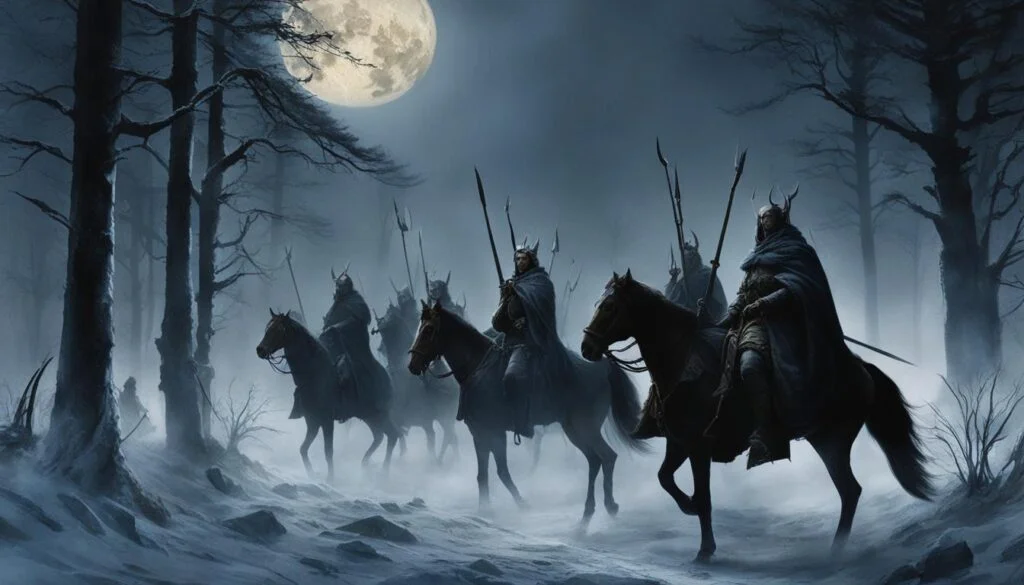
The Winter Solstice, marking the shortest day and longest night of the year, holds significance in Norse mythology and is often associated with the Wild Hunt. It is believed to be the time when the Wild Hunt is most active, representing the turning point towards longer days and the return of light.
Festivals and celebrations related to the Winter Solstice frequently incorporate references to the Wild Hunt, highlighting the cultural and mythological significance of this event. The Wild Hunt in Norse mythology timeline aligns with the Winter Solstice, creating a powerful connection between the celestial and the mythical.
The Winter Solstice acts as a symbolic bridge between the dark and the light, similarly to how the Wild Hunt represents the transition from one state to another. This synchronicity further emphasizes the intertwined relationship between nature, mythology, and human existence in Norse tradition.
Connections to Christmas Traditions
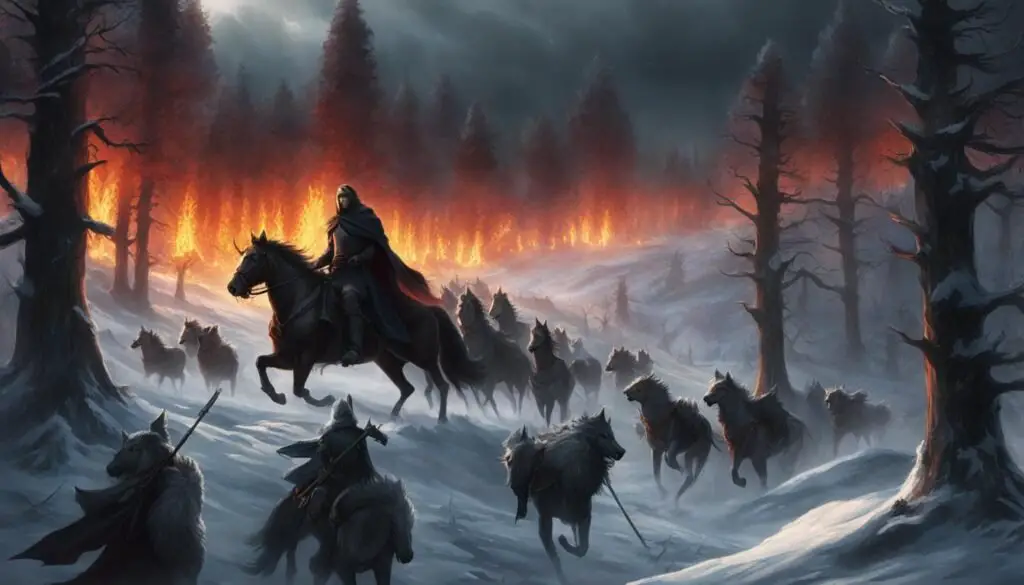
The traditions and folklore surrounding the Wild Hunt in Norse mythology have intriguing connections to some Christmas traditions. In particular, Odin, who is commonly associated with the Wild Hunt, bears similarities to the beloved figure of Santa Claus.
According to Norse tradition, children would leave treats for Odin’s eight-legged horse, Sleipnir, in hopes of receiving gifts in return. This act of offering treats to Odin may have influenced the development of the modern-day Christmas tradition of leaving out cookies and milk for Santa Claus.
The concept of stockings filled with treats can also be traced back to the Wild Hunt in Norse mythology. In Norse folklore, Odin was known to reward children by placing gifts in their shoes, which were left by the fireplace. Over time, this tradition evolved into hanging stockings by the fireplace, with Santa Claus filling them with presents on Christmas Eve.
Through these fascinating connections, the Wild Hunt in Norse mythology has left an indelible mark on Christmas traditions, adding a touch of ancient folklore and myth to the festive season.
These connections between the Wild Hunt and Christmas traditions illustrate the enduring influence of Norse mythology on our cultural celebrations. As we hang our stockings and indulge in festive treats, we can’t help but be reminded of the ancient hunt led by Odin through the wintry skies.
Mythical Symbolism and Natural Phenomena
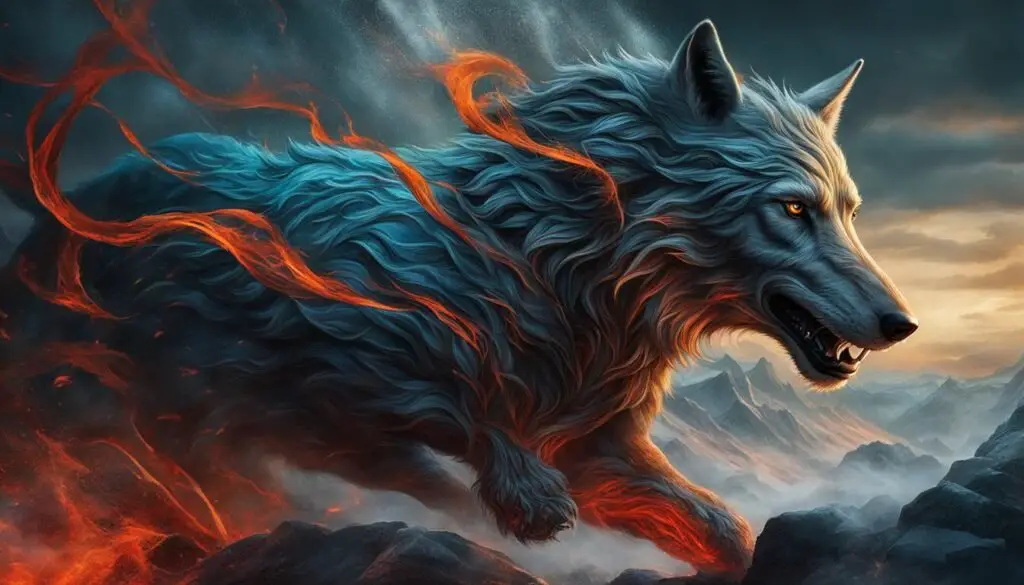
The Wild Hunt in Norse mythology serves as a mythical symbol for impending doom, often associated with war, plague, or famine. It is believed to be connected to natural phenomena, particularly thunderstorms.
The swirling shapes of the warriors in the hunt mirror the form of thunderstorms, and the sound of their pursuit can be compared to the rumble of thunder. The Wild Hunt represents the powerful forces of nature and the unpredictability of life.
Mythological Significance of the Wild Hunt
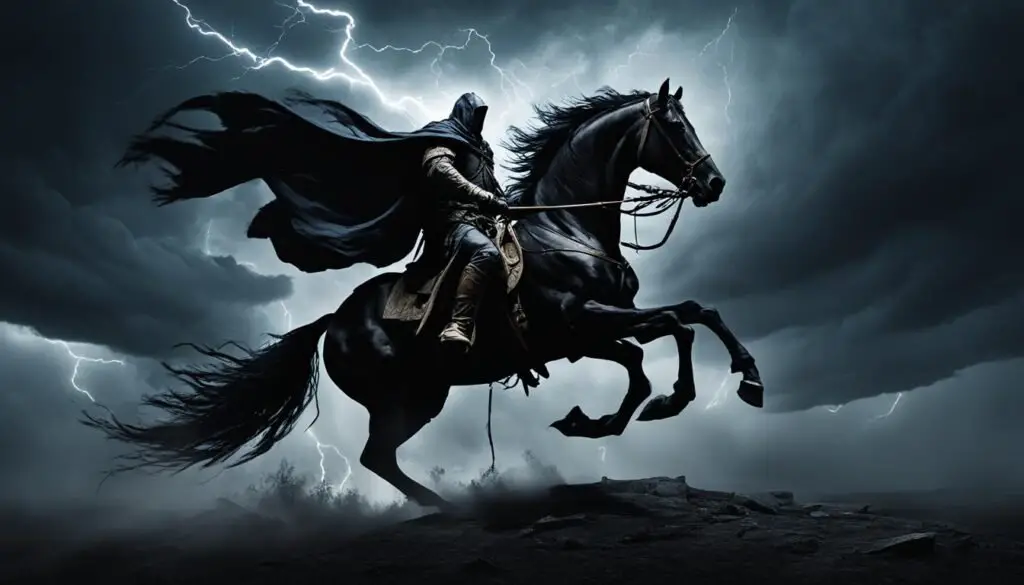
The Wild Hunt, a prominent element in Norse mythology, holds significant mythological symbolism, particularly in connection to the god Odin. As the god of war and the sky, Odin’s association with the Wild Hunt accentuates his role as a warrior deity, empowering this mythical event with a sense of divine power and awe.
The Wild Hunt also embodies the cyclical nature of life, representing the inevitability of death and rebirth. Just as the hunt relentlessly pursues its quarry, life and death are inextricably intertwined in the Norse belief system. Odin, as the leader of the hunt, exemplifies these mythological themes and adds depth to the symbolism of the Wild Hunt in Norse mythology.
Astronomical Connections
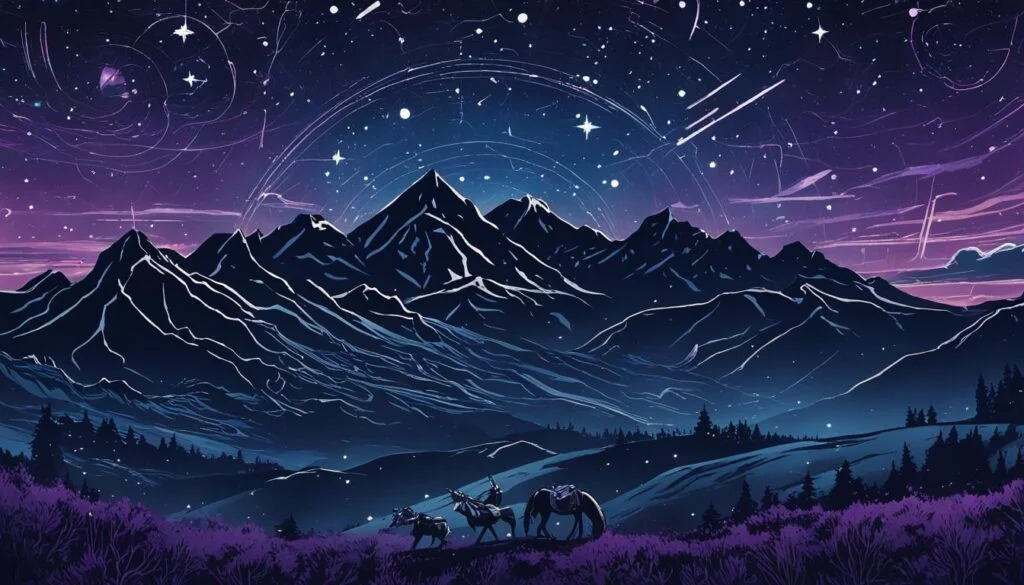
Throughout history, the Wild Hunt in Norse mythology has captivated the imaginations of many. As researchers delve deeper into the legends and folklore surrounding this mythical event, connections to astronomical phenomena have emerged.
Some believe that certain constellations, such as Orion and Taurus, are associated with the Wild Hunt. The positioning of these constellations during specific times of the year, particularly during the Winter Solstice, may have influenced the mythological stories that developed around the Wild Hunt in Norse mythology.
By studying the alignment of the stars and their correlation to the timing of the Wild Hunt, researchers have uncovered another layer of complexity to this intriguing phenomenon. These astronomical connections not only deepen our understanding but also add a sense of wonder to the myths and legends that have been passed down through generations.
Cultural Significance and Legacy
The Wild Hunt has left a lasting impact on Norse culture and mythology. It has become a prominent theme in various art forms, literature, and music, showcasing its cultural significance and enduring popularity.
In visual art, the Wild Hunt is often depicted in vivid and dramatic scenes, capturing the intensity and otherworldly nature of the hunt. Paintings, sculptures, and tapestries featuring the Wild Hunt adorn museums, galleries, and private collections around the world.
Literature has also been greatly influenced by the Wild Hunt, with numerous novels, poems, and short stories exploring its themes and characters. The hunt’s mysterious nature, the ghostly figures of the hunters, and the connection to Norse mythology have fascinated writers and readers alike.
Music, too, has embraced the Wild Hunt as a source of inspiration. Composers have created symphonies, operas, and songs that capture the spirit and energy of the hunt. The haunting melodies and powerful rhythms evoke the wild and mystical nature of this mythological creature.
The Wild Hunt’s cultural significance extends beyond Norse mythology. Its themes and symbolism have been adapted and incorporated into the folklore and legends of different cultures around the world. The concept of a spectral hunting party led by a mythical figure transcends boundaries, resonating with people from various backgrounds and belief systems.
The legacy of the Wild Hunt continues to captivate and intrigue people, contributing to the richness of Norse mythology and its influence on global culture. Its combination of mythological creatures, thrilling narratives, and deep symbolism ensures that the Wild Hunt remains an enduring and beloved aspect of human storytelling.
Conclusion
The Wild Hunt in Norse mythology is a captivating and multifaceted aspect of the Norse belief system. While the exact timing of the Wild Hunt is not clearly defined, it is often associated with the Winter Solstice, representing the transition towards longer days and the return of light. This mythical event holds significant mythological, cultural, and astronomical importance, symbolizing themes of war, natural phenomena, and the cyclical nature of life.
The legends and folklore surrounding the Wild Hunt continue to intrigue and inspire, showcasing the enduring power of Norse mythology. Its enigmatic nature and connection to various natural phenomena, such as thunderstorms, add to its mystique. Additionally, the Wild Hunt’s association with the Norse god Odin and its cultural significance in Norse tradition further solidify its place in the rich tapestry of Norse mythology.
Through art, literature, and music, the Wild Hunt has permeated Norse culture, leaving a lasting legacy. Its symbolism and themes have also influenced other mythologies and folklore worldwide, reinforcing the global appeal and relevance of Norse mythology. The Wild Hunt remains a testament to the enduring fascination with ancient beliefs and the ongoing exploration of our human connection to the natural world.
FAQ
When is the Wild Hunt in Norse mythology?
The exact timing of the Wild Hunt in Norse mythology is not clearly defined. However, it is often associated with the Winter Solstice, marking the turning point towards longer days.
What is the origin of the Wild Hunt?
The Wild Hunt has its origins in Germanic mythology and is documented by Jacob Grimm. In Norse mythology, it is often associated with the god Odin. Similar variations of the Wild Hunt can be found in other cultures such as Wales and England.
What does the Wild Hunt represent in Norse mythology?
In Norse mythology, the Wild Hunt represents impending doom and is often associated with war, plague, or famine. It is also linked to natural phenomena, particularly thunderstorms.
How is the Wild Hunt connected to the Winter Solstice?
The Winter Solstice, which marks the shortest day and longest night of the year, is often associated with the Wild Hunt. It is believed to be the time when the Wild Hunt is most active, symbolizing the turning point towards longer days and the return of light.
Are there any connections between the Wild Hunt and Christmas traditions?
Yes, the traditions and folklore surrounding the Wild Hunt in Norse mythology have influenced some Christmas traditions. Odin, associated with the Wild Hunt, has similarities to the figure of Santa Claus. Children would leave treats for Odin’s horse Sleipnir, and in return, Odin would leave gifts for them.
What does the Wild Hunt symbolize in relation to natural phenomena?
The Wild Hunt is believed to symbolize thunderstorms, with the swirling shapes of the hunters mirroring the form of thunderstorms. The sound of their pursuit can be compared to the rumble of thunder, representing the powerful forces of nature and the unpredictability of life.
What is the mythological significance of the Wild Hunt?
The Wild Hunt holds great mythological significance, particularly in relation to Odin. As a god of war and the sky, Odin’s association with the Wild Hunt highlights his role as a warrior deity. The Wild Hunt also represents the cyclical nature of life and the inevitability of death and rebirth.
Are there any astronomical connections to the Wild Hunt?
Some researchers have drawn connections between the Wild Hunt in Norse mythology and certain constellations, such as Orion and Taurus. The position of these constellations during specific times of the year, such as the Winter Solstice, may have influenced the mythological stories surrounding the Wild Hunt.
What is the cultural significance and legacy of the Wild Hunt?
The Wild Hunt has left a lasting impact on Norse culture and mythology. It is often portrayed in various forms of art, literature, and music, showcasing its cultural significance. The symbolism and themes associated with the Wild Hunt have also been adapted and incorporated into other mythologies and folklore around the world.
Why is the Wild Hunt in Norse mythology so intriguing?
The Wild Hunt in Norse mythology is a complex and intriguing aspect of the Norse belief system. Its exact timing may not be clearly defined, but its association with natural phenomena and its mythical symbolism captivate and inspire people, contributing to the enduring power of Norse mythology.


